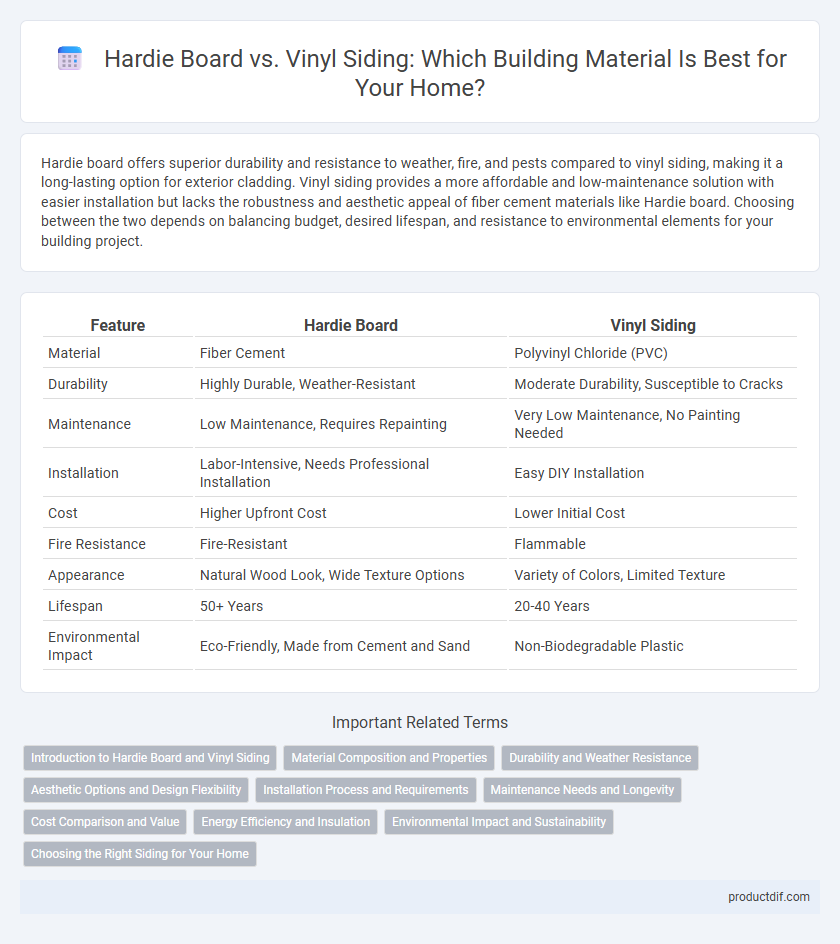Hardie board offers superior durability and resistance to weather, fire, and pests compared to vinyl siding, making it a long-lasting option for exterior cladding. Vinyl siding provides a more affordable and low-maintenance solution with easier installation but lacks the robustness and aesthetic appeal of fiber cement materials like Hardie board. Choosing between the two depends on balancing budget, desired lifespan, and resistance to environmental elements for your building project.
Table of Comparison
| Feature | Hardie Board | Vinyl Siding |
|---|---|---|
| Material | Fiber Cement | Polyvinyl Chloride (PVC) |
| Durability | Highly Durable, Weather-Resistant | Moderate Durability, Susceptible to Cracks |
| Maintenance | Low Maintenance, Requires Repainting | Very Low Maintenance, No Painting Needed |
| Installation | Labor-Intensive, Needs Professional Installation | Easy DIY Installation |
| Cost | Higher Upfront Cost | Lower Initial Cost |
| Fire Resistance | Fire-Resistant | Flammable |
| Appearance | Natural Wood Look, Wide Texture Options | Variety of Colors, Limited Texture |
| Lifespan | 50+ Years | 20-40 Years |
| Environmental Impact | Eco-Friendly, Made from Cement and Sand | Non-Biodegradable Plastic |
Introduction to Hardie Board and Vinyl Siding
Hardie board, composed of fiber cement, offers superior durability and resistance to fire, moisture, and pests compared to traditional siding materials. Vinyl siding, made from polyvinyl chloride (PVC), is lightweight, low-maintenance, and cost-effective with a wide range of color and texture options. Both materials provide distinct benefits in terms of longevity, aesthetic versatility, and weather resistance for residential and commercial building exteriors.
Material Composition and Properties
Hardie board, made from fiber cement, combines cement, sand, and cellulose fibers, offering exceptional durability, fire resistance, and resistance to rot and pests, making it ideal for harsh weather conditions. Vinyl siding is composed primarily of polyvinyl chloride (PVC), which provides a lightweight, low-maintenance, and water-resistant exterior but is more susceptible to cracking and fading over time. The fiber cement structure of Hardie board delivers superior impact resistance and longevity compared to the flexible, synthetic nature of vinyl siding.
Durability and Weather Resistance
Hardie board offers superior durability and weather resistance compared to vinyl siding due to its fiber cement composition, which withstands extreme conditions such as hail, wind, and moisture without warping or cracking. Its resistance to fire, insects, and rot further enhances its longevity, making it ideal for harsh climates. Vinyl siding, while more affordable and low-maintenance, tends to fade, crack, or become brittle under prolonged sun exposure and severe weather.
Aesthetic Options and Design Flexibility
Hardie board offers a wide range of aesthetic options, including various textures, colors, and profiles that mimic natural wood or stucco, providing superior design flexibility for custom architectural styles. Vinyl siding is available in many colors and styles but typically lacks the authentic appearance and texture variety of Hardie board. Homeowners seeking durable and visually versatile exteriors often prefer Hardie board for its ability to blend contemporary and traditional design elements seamlessly.
Installation Process and Requirements
Hardie board installation requires a weather-resistant barrier and corrosion-resistant fasteners, often necessitating skilled labor due to its heavier weight and precise fastening needs. Vinyl siding offers a simpler installation process with lightweight panels that can be nailed directly to the sheathing, typically reducing labor costs and time. Proper alignment and allowance for expansion and contraction are critical for vinyl siding, while Hardie board requires cutting tools suited for fiber cement to ensure clean, accurate edges.
Maintenance Needs and Longevity
Hardie board offers superior durability with a lifespan of up to 50 years and requires minimal maintenance, mainly periodic repainting every 10-15 years to maintain its appearance. Vinyl siding typically lasts 20-40 years and demands less upkeep, only occasional cleaning with soap and water, but is more prone to cracking or fading over time. Both materials provide weather resistance, but Hardie board's cement fiber composition grants it enhanced resilience against moisture, pests, and fire compared to vinyl.
Cost Comparison and Value
Hardie board typically costs between $8 to $12 per square foot, offering higher durability and fire resistance compared to vinyl siding, which averages $3 to $7 per square foot. Although vinyl siding is more affordable upfront, Hardie board provides better long-term value through increased lifespan and lower maintenance expenses. Investing in Hardie board enhances property value due to its superior aesthetics and resilience, making it a cost-effective choice for homeowners seeking durability and curb appeal.
Energy Efficiency and Insulation
Hardie board offers superior energy efficiency compared to vinyl siding due to its dense fiber cement composition, which provides better insulation against temperature fluctuations. Vinyl siding typically lacks significant insulating properties, often requiring additional foam backing to improve energy performance. Choosing Hardie board can reduce heating and cooling costs by enhancing a home's thermal envelope and resisting heat transfer more effectively.
Environmental Impact and Sustainability
Hardie board, made from fiber cement, offers enhanced durability and is composed of sustainable materials with low environmental toxicity, making it a more eco-friendly option compared to vinyl siding. Vinyl siding, derived primarily from polyvinyl chloride (PVC), poses environmental concerns due to its production emissions, non-biodegradability, and difficulty in recycling. Choosing Hardie board supports long-term sustainability efforts by reducing waste and minimizing harmful chemical exposure throughout its lifecycle.
Choosing the Right Siding for Your Home
Hardie board offers superior durability and resistance to fire, moisture, and pests compared to vinyl siding, making it ideal for homes in harsh climates. Vinyl siding is cost-effective and requires minimal maintenance, providing homeowners an affordable, lightweight option that resists fading and cracking. Evaluating factors such as budget, climate conditions, and long-term maintenance needs will help determine whether Hardie board or vinyl siding is the best fit for protecting and enhancing your home's exterior.
Hardie board vs Vinyl siding Infographic

 productdif.com
productdif.com